Snap Read online
I, Edwina Beckey, am a girl of lists.
I love lists of all kinds: to-do lists, grocery lists, homework lists, New Year’s resolutions, books read, books to be read, best friends, next-best friends, favorite names, favorite nicknames, favorite movies, favorite foods, favorite you name it. If more people made lists, the world would be more predictable and less chaotic.
That’s not to say that I myself am an organized person. Take my school desk, for example. Wouldn’t you think that, being a girl of lists, my school desktop could be lifted to reveal perfectly organized piles of books, notebooks, erasers, pens, pencils, and markers?
Not so.
My school desk is a mess. So is my desk at home. So are my bureau and my closet. I aspire to neatness and organization, but despite my list making, I have not yet attained it.
Here I am, in simple list form:
Name: Edwina Stiles Beckey.
Nickname: Eddie.
Home: North Sterns, New York, in the foothills of the Adirondack Mountains.
Family: Mother, Mildred. Father, Keith.
Grade: Just passed sixth, heading into seventh.
Pets: Hamster (deceased). Goldfish (three; deceased). Raccoon (deceased). Caterpillar (turned self into a butterfly).
Favorite season: Autumn.
Favorite color: Pine trees in winter.
Best friend: Sally Hobart.
I love not only lists but all listlike arrays of objects, such as rows of rubber bands. I have six of them, in all different colors, on my left wrist, to be snapped when necessary.
1. The red one: storing food in my cheeks when I eat.
“Eddie, sweetie, you’re not a chipmunk,” my father once said. “We have plenty of provisions to get you through the winter.”
2. The blue one: thinking of my best friend Sally Hobart’s grandmother as Willie instead of as Sally’s grandmother. Sally’s grandmother loves to walk. She walks to Sterns and back almost every day from the house where she lives with Sally, up here in North Sterns, in the foothills of the Adirondack Mountains, which is how Sally and I like to refer to our home. Sally’s grandmother carries a green pail in one hand and a stick in the other, and she swings her arms. Sometimes she sings. As we pass by on the school bus, she waves the pail and the stick back and forth over her head and shouts out our names, mine and Sally’s.
But Sally’s grandmother said to me recently, “My name is Willie, did you know that?”
I realized right in that moment that I had never called Sally’s grandmother by name, any kind of name. I had never said, “Mrs. Hobart,” or “Grandma Hobart,” or even “Hey.” And there was something in her voice, something that made me think she wanted to be called Willie.
So I added the blue rubber band to my wrist.
3. The yellow one: tipping back in chairs.
Sally and I like tipping back in chairs, but it hurts Sally’s grandmother — Willie — to see us do it. That’s because Willie’s childhood friend Sara tipped back too far in a chair the day she graduated from high school, and broke her neck and died. Every time Willie sees someone tipping back in a chair, she tells that person about Sara, about the navy blue velvet dress she was wearing and how fast it all happened.
When I see Sally tipping back in a chair, I give her a look and snap my yellow rubber band. But she just laughs and tips back farther.
4. The white one: covering my mouth when I laugh.
Once, at a restaurant in Utica with my parents, I saw a girl with short hair and slightly long bangs. She covered her mouth with her hand when she laughed, and since she seemed to laugh all the time, her hand was constantly covering her mouth. It annoyed me, the sight of this girl constantly laughing with her hand over her mouth. She was irritating. Then I realized that it was one of those restaurants with a mirror running all along the opposite wall, so that what you think is a whole other room is actually just the reflection of the room you yourself are sitting in.
The irritating girl was me.
5. The pink one: whistling under my breath so that it drives other people crazy.
I’m not a good whistler. What I call a whistle is a mutant form of whistling that sounds like the faintest recorder in the world playing itself out of tune. That’s what Sally told me once, anyway.
There’s another rubber band too.
6. Purple. It’s the one highest on my forearm. It hurts the most when it’s snapped. What I tell people, if they ask, is that my purple rubber band stands for “Remember to wear your glasses.” When I put my glasses on, the world is sharp-edged and bright. When teachers ask why I’m not wearing my glasses, I tell them that I just forgot to, which is sometimes true but sometimes not. Most people don’t know that a little fuzziness isn’t always a bad thing.
There’s another reason why I keep the purple band on my wrist. But that reason, I don’t talk about.
Sally Hobart is my best friend.
Here is a partial list of what I know about Sally:
Name: Sally Wilmarth Hobart.
Favorite smell: Wood smoke.
Favorite kind of cheese: Limburger.
Favorite season: Spring.
Favorite color: White.
Best friend: Eddie Beckey.
Favorite food: Chocolate-covered sprinkle doughnuts from the bakery at the back of Jewell’s Groceries.
I know so much else about Sally: her favorite books, the contents of her locker, the fact that on cheese pizza day she will buy, instead of bring, her lunch. Her preferred Monopoly piece, the only piece she will play with? The dog, because she’s always wanted one.
She used to suck her thumb but forced herself to stop.
Her favorite class is earth science.
Favorite body of water? The meander that twists its way through the meadow below her house.
Favorite place in the world? The Cabin, where every summer we go camping.
I could make a list of everything I know about Sally. But I wouldn’t because Sally says that my lists are “spontaneity crushers.”
Willie says that Sally is a sugar fiend.
“Sally,” Willie says, “consider the cave children. Did they wake up in the morning craving chocolate-covered sprinkle doughnuts?”
“Cave children probably ate bloody chunks of raw meat for breakfast,” Sally says. “And they lived in caves. I’d rather live in a house and eat sprinkle doughnuts.”
Willie thinks of herself as an anti-sugarist.
Given a choice between salty and sweet, Sally’s grandmother — Willie — will choose salty every time. That’s why she prefers crackers over cookies. She bakes them herself. She rolls the cracker dough out thin on a cookie sheet and pricks it all over with a fork. After the dough is baked, when it’s brown and cool, she breaks it into pieces. She bakes all kinds of crackers: cracked-pepper Parmesan, plain soda, Vermont cheddar with maple syrup. Sometimes I look up cracker recipes in the library so as to test her with the names of weird ones. Crackers I had never even imagined the existence of, Sally’s grandmother knows all about.
But still, she buys sprinkle doughnuts for Sally.
“One of these days I’m going to stop and buy chunks of raw meat instead so that you can work on your cave-girl technique,” she says. “You just watch.”
She’s been saying that for years.
What Sally loves most: Willie.
What Willie loves most: Sally.
I once would have thought there was nothing I didn’t know about my best friend, but on the last day of sixth grade, that changed. Sally and I were riding the bus home to North Sterns, out here on the Remsen border, where the foothills rise up purple and shadowy, and it came to me that I hadn’t seen Sally’s grandmother for a while. Where was she? Why was she not tromping her way south along Route 274, scissoring both her arms at us
to say hello as we passed her? Where was she, Willie, with her green pail and her keep-away-the-dogs stick?
I realized that I had not been to dinner at Sally’s house in a while. I could see the red-and-white checked tablecloth that Willie spreads in my honor, and I could smell the spaghetti sauce she makes for us, her hours-long spaghetti sauce whose secret ingredient is V8 juice — yes, V8 — bubbling away on the stove.
“Sally? Where’s your grandmother?”
Sally was next to me on the long green vinyl seat of the bus, eight seats behind Shari, the driver. Sally had opened up her lunch box and was eating the apple she hadn’t eaten at lunch. She usually saves something for the bus ride. It’s a long one, especially the way Shari drives. You would think, looking at her, that Shari would drive fast and curse a lot, but no.
“Sally?”
Sally munched on.
“Is she sick?”
“She’s fine,” Sally said, around her mouthful of apple.
“Why isn’t she out walking, then?”
Sally sat there next to me on the green vinyl seat, crunching away on that apple. She didn’t look at me. Something flitted through me, a shadow of a feeling that made my stomach flutter. I gazed out the bus window and willed Willie to appear. I willed her arms to be up in the air, waving her hello to us. I willed her to be around the next curve, her big smile and her green pail. She wasn’t.
Sally didn’t say anything. I felt for my purple rubber band.
Snap.
In the woods behind the Cabin, a blue bicycle hangs in a tree. As far as I know, only two people here in Sterns know about the blue bicycle, and those two people are Sally and me. We discovered it by accident one day when we were seven, which according to Sally’s grandmother — Willie — is the age of reason.
“So,” Willie said. “Seven.”
It was July, the summer after second grade. Sally and I were born in July. We were standing in her kitchen.
“Seven,” Willie said again. “The age of reason. Has the world unfolded itself to you in all its mystery and power, and do you now understand your purpose in it?”
Sally and I looked at each other, then back at Willie. We nodded.
But we had no idea what she was talking about.
“Excellent,” she said. “Have a cracker.”
We ate our crackers and went out to the woods near the Cabin. Maples and oaks, mostly, with a few butternuts here and there. That day, we went farther than we had ever gone before, into what felt like deep woods.
It was Sally who saw it first. She pointed, and my eyes followed her pointing finger.
“Is that a bicycle?” I said.
Sally lowered her finger.
“Yes, it is,” I answered myself. “It’s a blue bicycle.”
We stood there shading our eyes against the sun and staring up at that maple tree, the maple tree where a blue bicycle hung suspended, its frame and one tire wrapped around — grown into — the branches. The blue bicycle had been in that tree for a long time. Even at seven we knew enough to know that.
We weren’t old enough yet to wonder about how it got there in the first place, who had brought a blue bicycle into these forgotten woods, or why. We just stood and looked up in the tree, high up where the bicycle hung, one wheel twirling slowly in the breeze, so slowly that the sunlight sparkling off its rusty chrome seemed like a mirage.
Whose bicycle was it?
Sometimes I wonder about that. It’s the same kind of bicycle that Sally and I used to ride when we were seven and eight and nine, when I would keep lists that tracked our speed and distance using the speedometers that Willie bought us.
Fastest downhill: William T. Jones’s hill: 35 mph on a very windy day two years ago, a speed we have never been able to replicate.
Distance from Sally’s house to mine the short way: 2.1 miles.
Distance from Sally’s house to mine the long way: 3.4 miles.
You can lean your head back, and shade your eyes if it’s a sunny day, and gaze up to the top of that gigantic maple, and there the bicycle will be. Rusting in spots; shining in others. On windy days, when the slender branches near the top of the maple toss and turn, one wheel of the bicycle spins. It looks lazy, that wheel, as if it knows that its purpose in life used to be to get places and go somewhere, but now all it has is air to turn against.
I used to think that nothing much would ever change from the way it was. But the first day of summer, the first hour of summer, as I was walking by myself in the bicycle woods in search of double acorns to add to my double-acorn collection, I glanced up to my left to see how the bicycle was doing.
And it was no longer a bicycle.
What used to be a blue bicycle had become encircled and covered over by the limbs of the tree. The blue bicycle is no longer itself. Is that the way it is with everything? Is everything in this world changing all the time, in little ways, ways I can’t even see?
Sally’s grandmother — Willie — changed, and I never saw it coming. The first inkling I had was that last day of school, on the bus, when Sally wouldn’t look at me or answer my questions.
Willie has carried a green pail by her side for as long as I’ve known her. No purse for her. Pail in hand, Willie walks the five miles into Sterns come sleet, come hail, come rain, come snow. The way Willie walks is the way a person who has walked her entire life walks. She gulps up the road. Her pail goes into Sterns empty and comes back with a loaf of bread sticking out of it. A roll of stamps. A library book or three or four for Sally. Red and orange maple leaves, I saw piled in there once, bright against the green of the plastic pail. Next time I went to their house, those leaves had been pressed between wax paper and were hanging in the kitchen window to catch the sun.
As long as I can remember, Willie has gotten up early on Sunday morning and walked into Sterns. She brings back chocolate-covered sprinkle doughnuts. She sits at the kitchen table with us. We eat the doughnuts and Willie watches us, her voice a small waterfall of words and laughter. This has been our routine for years.
“Don’t you want a doughnut?” I asked her once, way in the beginning, before I knew how she felt about sugar.
“Thank you, Eddie, but unlike my granddaughter, I’m not much of a sugar person,” she said. “I do love a good doughnut hole, though.”
She reached over to my doughnut and pretended to pluck out the hole, which because it was a hole was already gone. And she ate it. I watched her as she rolled her eyes and smiled and pretended to chew.
“Heavenly,” she said. “Indescribably, existentially delicious.”
And I could almost taste that hole myself, even though a hole is by definition nonexistent. I could almost feel it filling my mouth with its indescribably, existentially delicious flavor.
Until now, nothing about Willie had ever changed, her walking, her green pail, her buying of sprinkle doughnuts for Sally, the way she spread a red-and-white checked tablecloth on the kitchen table whenever I went to their house. But none of this had happened lately. Sunday mornings have come and gone, and there have been no sprinkle doughnuts.
I never thought about it, but if I had, I would have assumed that Willie would stay the same forever, and Sally would live with her, here in Sterns, in the foothills of the Adirondacks, until Sally was grown-up and had a job and a house and maybe a dog even, the dog she’s always wanted.
Sally’s and my Cabin is down the hill past the cornfield, through the woods behind Sally’s house, where she lives with her grandmother. Not everyone calls the Cabin a cabin.
What my mother calls it: A shack.
What Sophie, waitress at Queen of the Frosties, calls it: A hut.
What Sally’s grandmother — Willie — calls it: A hovel.
The first time Sally and I told Willie that we wanted to go camping at the Cabin by ourselves, she headed down there with her keep-away-the-dogs stick. She poked and jabbed at the Cabin, inside and out. She had to bend down to get through the doorway, and Sally’s grandmother
— Willie — is not a tall woman.
“This used to be a chicken coop,” she said. “Did you know that?”
She put both hands against the falling-down roof and shoved with all her strength. The Cabin swayed but it did not fall. Willie dusted off her hands and squinted.
“Well, it’s far removed from the halcyon days of its chicken coop youth,” she said. “But I guess it’s not likely to fall down on your heads while you lie sleeping.”
That was how Willie gave us her permission.
Sally and I have a pact that when camping at the Cabin, we head into the wilderness with our doubled-up grocery bags of supplies and live off the land. No returns to her house or mine are allowed.
And no lists prior to packing.
“You make too many lists,” Sally says. “There should be one area of Eddie life that is list free, and I decree that area to be the Cabin.”
I wanted to go camping the first weekend that school was out.
“Let’s go,” I said to Sally.
We were sitting on the front step of her house, the front step that has both our handprints in one corner. The day the concrete was poured, Willie had called us out to render our handprints immortal. That was the way she put it.
“Let’s go this weekend,” I said.
No answer.
“It’d be so much fun,” I said. “The roaring fire, the smell of wood smoke. The s’mores.”
No answer.
Sally sat next to me with two sticks in her lap. Twigs on the ground in front of her formed a sort of cone shape. Beneath them she had piled some pine needles and a few old leaves that didn’t look very dry. Her entire life Sally has wanted to start a fire by rubbing two sticks together. It’s one of her dreams.
“What do you say? Camping at the Cabin this weekend?”
No answer.
“Imagine a nicely toasted marshmallow,” I said, “a soft chocolate bar, and a crisp graham cracker.”
No answer.
“I dream of s’mores.”

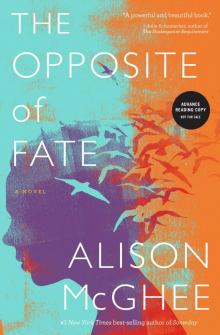 The Opposite of Fate (ARC)
The Opposite of Fate (ARC)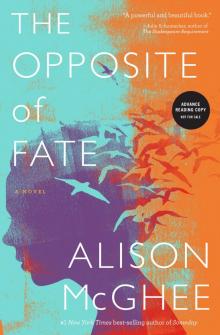 The Opposite of Fate
The Opposite of Fate What I Leave Behind
What I Leave Behind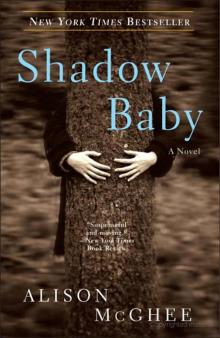 Shadow Baby
Shadow Baby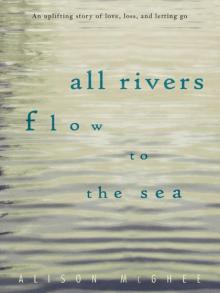 All Rivers Flow to the Sea
All Rivers Flow to the Sea Was It Beautiful?
Was It Beautiful?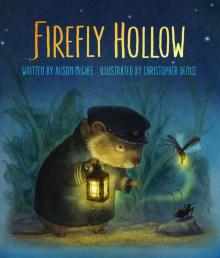 Firefly Hollow
Firefly Hollow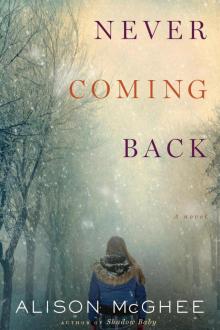 Never Coming Back
Never Coming Back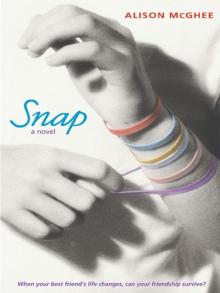 Snap
Snap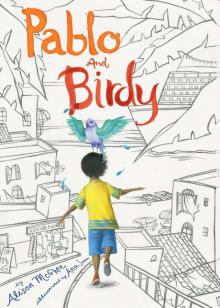 Pablo and Birdy
Pablo and Birdy